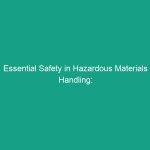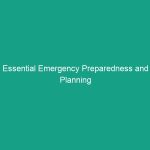Good Morning Team!
Today, we’re diving into a critical aspect of Workplace Safety that often gets overlooked—managing wildlife in the workplace safely. Whether we work in an office, warehouse, or outdoor site, we can encounter various forms of wildlife. Understanding how to manage these encounters is crucial not only for our Safety but also for the animals we might come across.
Understanding Essential Guidelines for Managing Wildlife in the Workplace Safely
The phrase “Essential Guidelines for Managing Wildlife in the Workplace Safely” refers to the practices and protocols we need to follow to ensure that our interactions with wildlife do not pose risks to ourselves, our colleagues, or the animals themselves. This is especially important in areas where wildlife is prevalent, such as near wooded areas, water bodies, or even urban settings where animals may seek food or shelter.
Many employees mistakenly believe that wildlife encounters are rare or that they can handle these situations on their own. However, wildlife can pose serious risks, including injury from bites or scratches, disease transmission, and property damage. By being aware of our surroundings and following established guidelines, we can mitigate these risks effectively.
Key Hazards, Risks, and Safety Considerations
When it comes to managing wildlife in the workplace, there are several Hazards and risks to be aware of:
- Animal Bites and Scratches: Encounters with wildlife can lead to bites or scratches, which may require medical attention.
- Diseases: Wildlife can carry various diseases, such as rabies, hantavirus, and Lyme disease, which can be transmitted to humans.
- Property Damage: Animals can cause damage to property, leading to costly repairs and potential safety hazards.
- Environmental Impact: Displacing wildlife or disturbing their habitats can have negative Effects on local ecosystems.
Ignoring these risks can lead to severe consequences, including health issues, legal ramifications, and increased workplace injuries. It’s vital to recognize these hazards and take proactive steps to address them.
Best Practices, Procedures, & Actionable Advice
Now that we understand the risks, let’s discuss some Best Practices for managing wildlife safely:
1. Awareness and Education
Stay informed about the types of wildlife that may be present in your workplace. Familiarize yourself with their behaviors and habitats to recognize potential encounters. Conduct regular Training sessions to educate employees on how to react in wildlife situations.
2. Avoiding Attractants
Minimize factors that attract wildlife to your workplace. This includes:
- Properly securing trash containers.
- Cleaning up food spills immediately.
- Avoiding leaving food out in common areas.
3. Safe Removal Practices
If you encounter wildlife on the premises, do not attempt to remove or handle the animal yourself. Instead:
- Contact a wildlife control professional.
- Keep a safe distance from the animal.
- Inform your supervisor or safety officer immediately.
4. Emergency Procedures
Establish clear emergency procedures for wildlife encounters. Ensure all employees know whom to contact and what steps to take if they see wildlife on-site. Conduct drills to practice these procedures.
5. Reporting Incidents
Encourage employees to report any wildlife sightings or encounters immediately. Keeping a log of these incidents can help identify patterns and improve Safety Measures.
Regulations, Standards, and Compliance
Understanding the legal and safety Regulations surrounding wildlife management is crucial. Key regulations include:
- OSHA Standards: The Occupational Safety and Health Administration (osha) provides guidelines for Workplace Safety, including managing wildlife hazards.
- Local Wildlife Laws: Familiarize yourself with local laws regarding the treatment and management of wildlife.
- Company Policies: Adhere to your company’s specific policies regarding wildlife encounters and reporting procedures.
Compliance with these regulations not only protects employees but also ensures that we respect wildlife and their habitats.
Employee Engagement & Discussion
We want to hear from you! Let’s take a moment to discuss:
- Have you ever encountered wildlife while at work? What was your experience?
- What challenges do you think we face in managing wildlife in our workplace?
- How can we improve our current wildlife management practices?
Conclusion & Key Takeaways
In summary, managing wildlife in the workplace safely is everyone’s responsibility. By understanding the hazards, following Best Practices, and staying compliant with regulations, we can create a safer Environment for ourselves and the wildlife around us. Remember, safety doesn’t stop at the workplace; it extends to our interactions with the natural world.
Thank you for your attention and commitment to safety. Let’s work together to ensure our workplace is safe for everyone!


